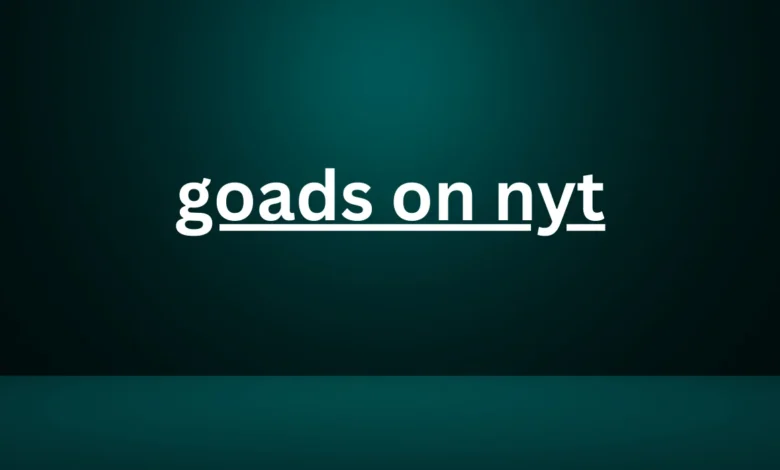Exploring Goads on NYT: Insightful Analysis

Welcome to our in-depth exploration of goads on the New York Times (NYT) and their impact on the world of journalism. In this article, we will delve into the concept of goads on NYT and provide a detailed analysis of their implications. By examining the role, influence, and effects of goads, we aim to shed light on how they shape the news landscape.
Goads play a significant role in shaping the direction and narrative of news stories. From headlines to content, goads influence the way information is presented to the public, ultimately shaping their perceptions and opinions. Goads can be in the form of editorial decisions, biases, or even external pressures.
Understanding the role of goads on NYT is crucial in comprehending how news stories are crafted and disseminated. By analyzing specific examples, we will gain insights into the power and influence goads have in shaping the narrative within the New York Times and, consequently, the wider media landscape.
Furthermore, this article will explore the impact of goads on NYT narratives. We will critically examine how goads can steer the direction of news coverage and potentially affect the accuracy, objectivity, and fairness of the information presented by the renowned newspaper. Through a thoughtful analysis, we aim to provide an understanding of the implications associated with the influence of goads.
Join us as we delve into the fascinating world of goads in the New York Times, unraveling their significance within the realm of journalism. Through insightful analysis, we will unveil the intricate ways goads shape the news we consume daily.
The Role of Goads on NYT
Goads play a pivotal role in shaping news stories, influencing public opinion, and driving the narrative within the New York Times (NYT). These subtle yet powerful tools are employed by journalists, editors, and other stakeholders to guide the direction and tone of the news presented to readers. By examining specific examples, we can gain a deeper understanding of the pervasive influence of goads within the NYT.
Goads on NYT are strategic elements that serve the purpose of directing attention, evoke emotional responses, and ultimately influence the perception of readers. They prompt journalists and editors to highlight certain aspects of a story, create a specific narrative, or emphasize particular viewpoints.
The newspaper industry, including the NYT, operates within a competitive landscape where capturing readers’ attention is crucial. Goads are integral to this process, as they are carefully crafted to pique interest, evoke curiosity, or provoke emotional responses that engage readers. By strategically using goads, NYT writers can successfully captivate their audience—a vital aspect for the sustainability of the newspaper.
Through the use of goads on NYT, journalists can shape public opinion and influence the broader discourse. By emphasizing certain angles or perspectives, they steer the narrative in a particular direction. This underscores the responsibility that comes with utilizing goads, as they have the power to shape public perception and sway public opinion.
Furthermore, goads on NYT can also contribute to driving the conversation and setting the agenda for public discourse. When specific topics or issues are consistently highlighted by goads, they receive increased attention and become a focal point of societal discussions.
It’s important to note that goads should be employed ethically and responsibly. While they serve the purpose of capturing readers’ attention and shaping the narrative, journalists must strive for accuracy, objectivity, and fairness in their reporting. The inclusion of goads should not compromise these journalistic principles but rather complement them by engaging readers and providing diverse perspectives.
By analyzing and understanding the role of goads on NYT, readers can better navigate the complex media landscape and critically evaluate the news they consume. This awareness enables them to identify the influence of goads and evaluate the overall credibility and objectivity of the news stories presented by the New York Times.
Impact of Goads on NYT Narratives
When it comes to the New York Times, the power of goads in shaping narratives cannot be underestimated. Goads play a crucial role in steering the direction of news coverage and influencing public perception. These subtle yet effective tactics have significant implications for the accuracy, objectivity, and fairness of the news presented by the esteemed publication.
By analyzing the impact of goads on NYT narratives, we can uncover the extent to which these strategies shape public opinion. Goads can manipulate the way stories are framed and the emphasis placed on certain aspects. They can subtly influence readers’ understanding of events, leading to a particular interpretation that aligns with the narrative favored by the New York Times.
“Goads are carefully crafted to evoke specific emotions and reactions from the readers. They are often used to drive home a particular point of view or agenda, subtly swaying public sentiment.”
The use of goads on NYT can have a profound impact on the overall credibility of the publication. When news is presented through the lens of goads, it raises questions about the impartiality and fairness of the reporting. Readers may question whether the news they consume is truly objective or influenced by underlying biases and agendas.
It is essential for readers to critically evaluate the presence of goads when engaging with articles and opinion pieces in the New York Times. By recognizing the potential impact of these tactics, readers can approach the news with a discerning eye and seek alternative perspectives to gain a well-rounded understanding of the issues at hand.
As consumers of news, we have the responsibility to be aware of the influence of goads and the potential consequences they may have on our perception of current events. By fostering media literacy and critical thinking, we can navigate the complexities of news narratives and make informed judgments that align with our values and beliefs.
Conclusion
Throughout our analysis of goads on NYT, we have uncovered their immense influence within the realm of journalism. Goads play a pivotal role in shaping news stories, driving the narrative, and influencing public opinion. The New York Times, as a renowned publication, is not immune to the power of these goads.
Our exploration into the impact of goads on NYT narratives revealed how they can steer the direction of news coverage, sometimes compromising accuracy, objectivity, and fairness. Goads have the potential to mold public perception and shape the discourse within the news landscape.
As we conclude, it is crucial to recognize the significance of goads on the New York Times and its position as a trusted source of information. Understanding the role of goads allows us to approach news consumption with a critical lens, discerning the underlying forces that shape the stories we read. By questioning the influence of goads, we empower ourselves to engage in a more informed and objective dialogue.




